Crank J. Free and Moving Boundary Problems
Подождите немного. Документ загружается.

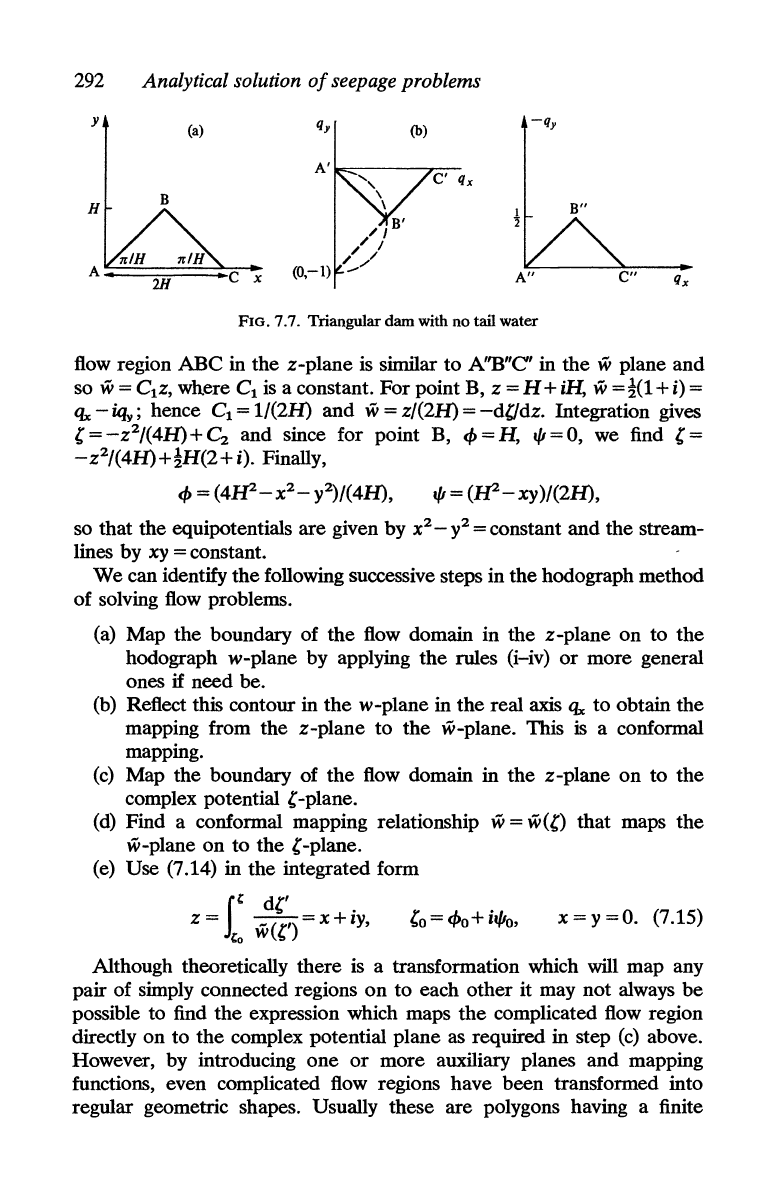
292
Analytical solution
of
seepage problems
y
(a)
(b)
B
FIG. 7.7. Triangular dam with no tail water
flow region
ABC
in
the
z-plane
is similar
to
A''B''C' in
the
w plane
and
so w = C1z, where C
1
is a constant.
For
point B, z = H + iH, w =
!(1
+
i)
=
llx -
iqy;
hence C
1
=
1/(2H)
and
w = z/(2H) =
-dgdz.
Integration gives
{=-z2/(4H)+C
2
and
since for point B,
cf>=H,
I{i=O,
we find
{=
-z2/(4H)+!H(2+i).
Finally,
cf>
=
(4IP-x
2
_y2)/(4H),
I{i
=
(IP-xy)/(2H),
so that
the
equipotentials
are
given
by
x
2
-
y2
= constant
and
the
stream-
lines
by
xy = constant.
We
can identify
the
following successive steps in
the
hodograph method
of
solving flow problems.
(a)
Map
the
boundary
of
the
flow domain
in
the
z-plane
on
to
the
hodograph w-plane by applying
the
rules (i-iv)
or
more
general
ones
if
need
be.
(b) Reflect this contour in
the
w-plane in
the
real axis llx
to
obtain
the
mapping from
the
z-plane
to
the
w-plane. This is a conformal
mapping.
(c)
Map
the
boundary
of
the
flow domain in
the
z-plane
on
to
the
complex potential {-plane.
(d)
Find
a conformal mapping relationship w =
w({)
that
maps
the
w-plane
on
to
the
{-plane.
(e)
Use
(7.14) in
the
integrated form
1
,
d{'
.
z =
'0
w({')
= x +
'y,
x=y=O.
(7.15)
Although theoretically
there
is a transformation which will
map
any
pair
of
simply connected regions
on
to
each
other
it
may
not
always
be
possible to find
the
expression which maps
the
complicated flow region
directly
on
to
the
complex potential plane as required in step
(c)
above.
However, by introducing
one
or
more
auxiliary planes
and
mapping
functions, even complicated flow regions
have
been transformed into
regular geometric shapes. Usually these are polygons having a finite
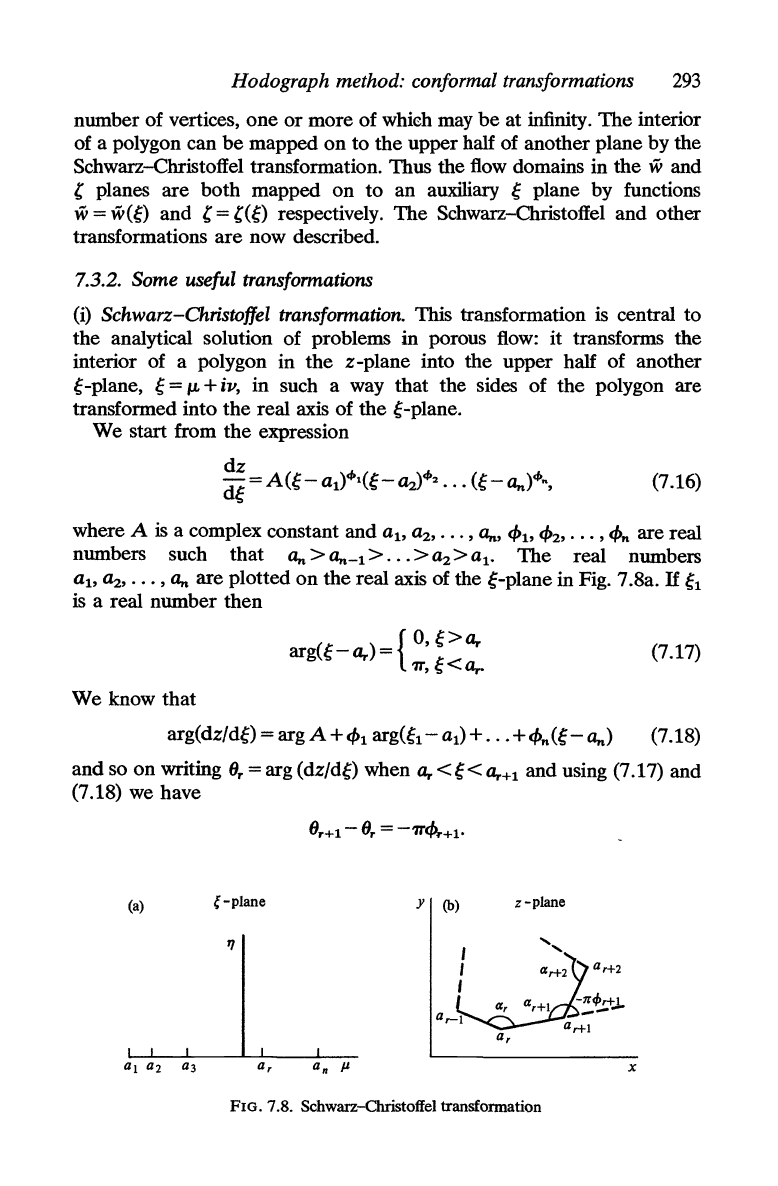
Hodograph method: conformal transformations
293
number of vertices,
one
or
more of whieh may
be
at infinity.
The
interior
of a polygon can
be
mapped
on
to
the
upper half of another plane by the
Schwarz-Christoffel transformation. Thus the flow domains in the
w and
, planes are both mapped on
to
an auxiliary g plane by functions
w = w(g) and
,=
,(g)
respectively.
The
Schwarz-Christoffel and other
transformations
are
now described.
7.3.2.
Some useful transformations
(i)
Schwarz-Christoffel transformation. This transformation is central to
the analytical solution of problems in porous
flow:
it transforms the
interior of a polygon in
the
z-plane into the upper half of another
{;-plane,
g =
IJ.
+
iv,
in such a way that the sides of
the
polygon are
transformed into
the
real axis of the {;-plane.
We start from
the
expression
dz
d{;
=
A({;
-
at)c/>l({;
-
~c/>2
...
({;
-
a,,)c/>n,
(7.16)
where A
is
a complex constant and
at>
lIz,
...
,
a",
q,t>
ch.,
...
,cf>..
are real
numbers such that
a"
> a,,-t >
...
> a
2
>
at.
The real numbers
at>
a
2
,
•••
,
a"
are plotted
on
the real axis of the {;-plane in Fig. 7.8a.
If
{;t
is
a real number then
We know that
{
0,
{;>a,
arg({;
- a,) =
'7T,
{; < a,.
arg(dz/d{;) = arg A + q,t
arg({;t
- at) +
...
+
q,n
({;
-
a,,)
(7.17)
(7.18)
and so on writing 6
r
= arg (dzld{;) when
a,
< g < a,+t and using (7.17) and
(7.18) we have
(a)
("
-plane
Y (b)
z -plane
'1
x
FIG. 7.8. Schwarz-cbristoffel transfonnation
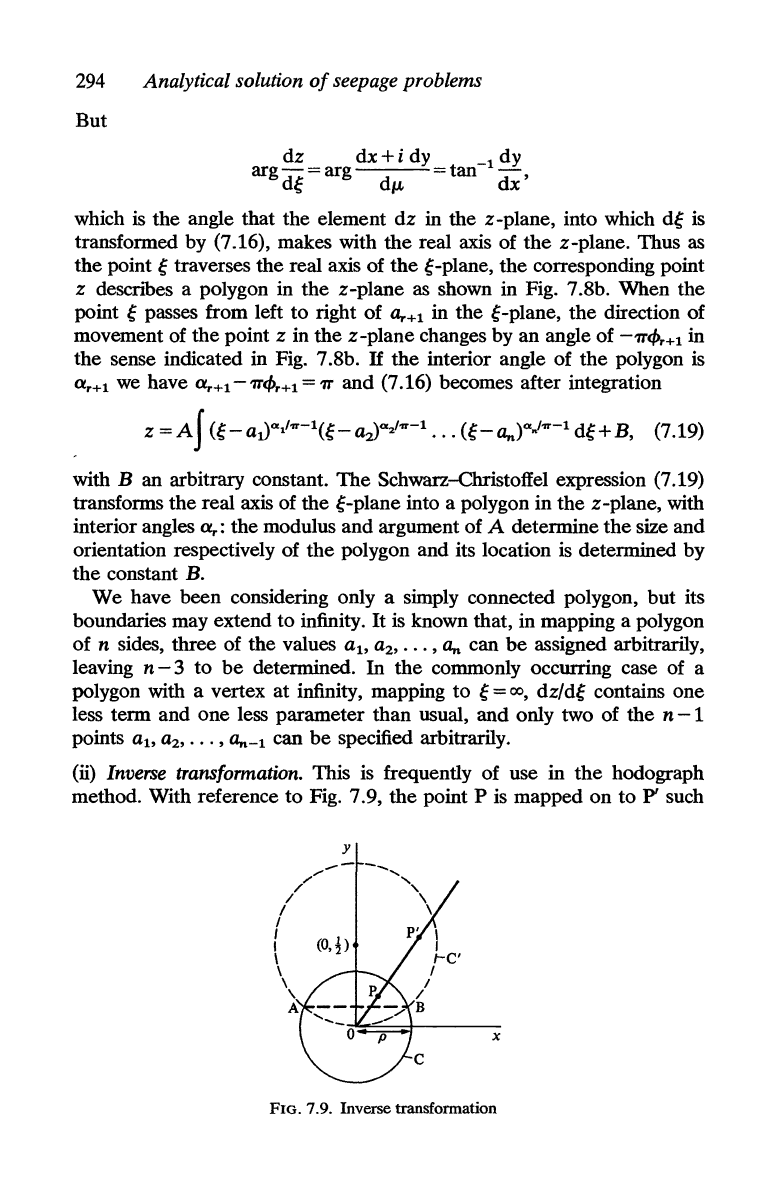
294
Analytical solution
of
seepage problems
But
dz
dx+i
dy
-1
dy
arg
d~
= arg
d""
tan
dx
'
which
is
the angle that the element
dz
in the z -plane, into which
d~
is
transformed by (7.16), makes with
the
real axis of
the
z-plane. Thus
as
the
point
~
traverses the real axis of
the
~-plane,
the corresponding point
z descnbes a polygon in
the
z-plane as shown in Fig. 7.8b. When the
point
~
passes from left
to
right of
a..+1
in the
~-plane,
the
direction of
movement of
the
point z in
the
z-plane changes by an angle of -'lTc/>r+1 in
the
sense indicated in Fig. 7.8b.
If
the interior angle of
the
polygon
is
G:
r
+ 1 we have 0:.+1 -
'lTc/>r+
1 =
'IT
and (7.16) becomes after integration
z
=AJ
(~-al)'·,/""-l(~_~ai""-l
...
(~_tIn)aft/""-l
d~+B,
(7.19)
with
B an arbitrary constant.
The
Schwarz-Christoffel expression (7.19)
transforms
the
real axis of
the
~-plane
into a polygon in the z-plane, with
interior angles
0:.: the modulus and argument of A determine
the
size and
orientation respectively of
the
polygon and its location is determined by
the
constant B.
We
have been considering only a simply connected polygon, but its
boundaries may extend to infinity.
It
is
known that, in mapping a polygon
of
n sides, three of
the
values
at>
a2'
...
,
tIn
can
be
assigned arbitrarily,
leaving
n - 3 to
be
determined.
In
the
commonly occurring case of a
polygon with a vertex at infinity, mapping
to
~=oo, dz/d~
contains one
less term and one less parameter than usual, and only two of the
n-1
points
at>
a2,
...
, tIn-l can
be
specified arbitrarily.
(ii) Inverse transformation. This is frequently of use in
the
hodograph
method. With reference to Fig. 7.9,
the
point P is mapped on to
P'
such
y
/,'--
--..
.......
,
/ ,
/ \
I \
I
I
(O,~)
\
\
\
A
x
FIG. 7.9. Inverse transformation
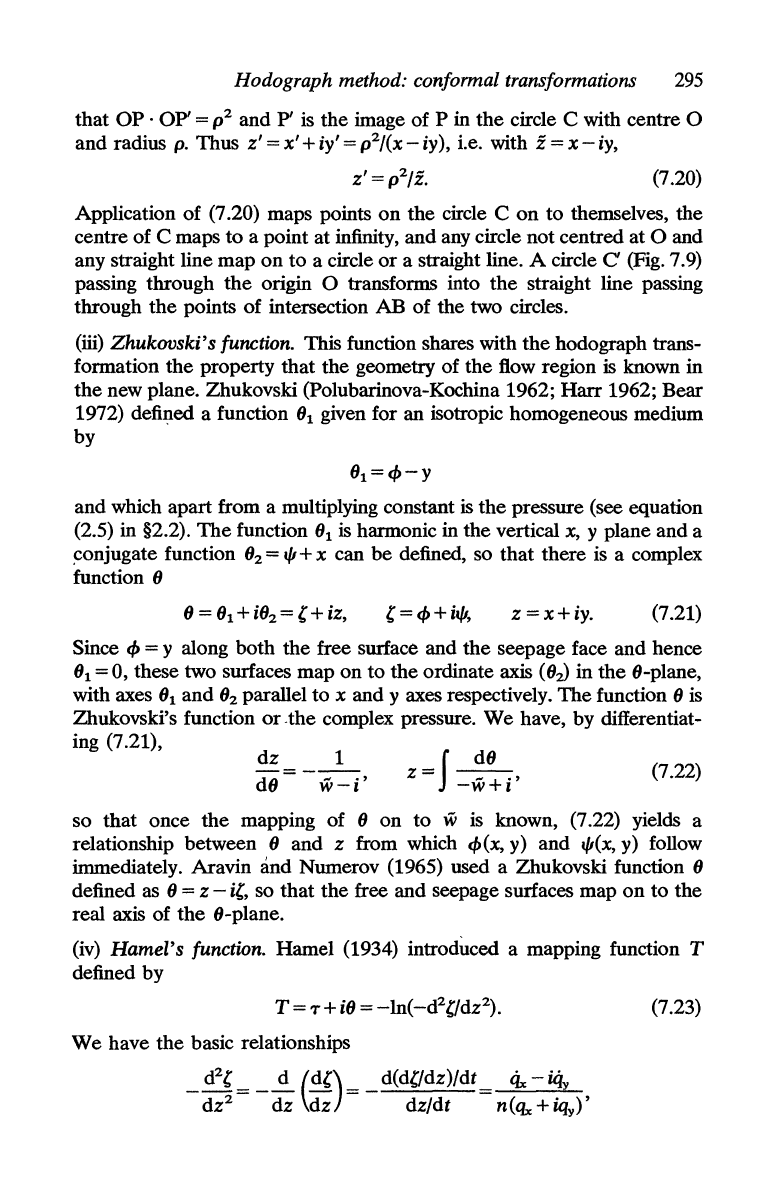
Hodograph method: conformal transformations
295
that
OP
.
OP'
= p2
and
P'
is
the
image
of
P in
the
circle C with centre 0
and
radius
p.
Thus
z'
= x' + iy' = p2/(X - iy), i.e. with z = x - iy,
(7.20)
Application
of
(7.20) maps points
on
the
circle C
on
to
themselves,
the
centre
of
C maps
to
a point
at
infinity,
and
any circle
not
centred
at
0 and
any straight line
map
on
to
a circle
or
a straight line. A circle C (Fig. 7.9)
passing through
the
origin 0 transforms into
the
straight line passing
through
the
points
of
intersection
AB
of
the
two circles.
(iii) Zhukovski's function. This function shares with
the
hodograph trans-
formation
the
property
that
the
geometry
of
the
flow region is known in
the
new plane. Zhukovski (Polubarinova-Kochina 1962;
Harr
1962;
Bear
1972) defined a function 6
1
given for an isotropic homogeneous medium
by
6
1
= cf>-y
and
which apart from a multiplying constant is
the
pressure (see equation
(2.5) in §2.2).
The
function 6
1
is harmonic in
the
vertical
x,
y plane
and
a
conjugate function 6
2
=
I{i
+ x can
be
defined, so
that
there
is a complex
function 6
6 = 6
1
+ i6
2
= , + iz,
z
=x+iy.
(7.21)
Since
cf>
= y along
both
the
free surface
and
the
seepage face
and
hence
6
1
=0,
these two surfaces
map
on
to
the
ordinate axis (6z)
in
the
6-plane,
with axes 6
1
and
6
2
parallel
to
x
and
y axes respectively.
The
function 6 is
Zhukovski's function
or
.the complex pressure.
We
have, by differentiat-
ing (7.21),
dz
1
-=---
d6
w-i'
z=J
~6+
.,
-w
l
(7.22)
so
that
once
the
mapping
of
6
on
to
w is known, (7.22) yields a
relationship between 6
and
z from which
cf>(x,
y)
and
I{i(x, y) follow
immediately. Aravin
and
Numerov (1965) used a Zhukovski function 6
defined as 6 = z - i', so
that
the
free
and
seepage surfaces map
on
to
the
real axis of
the
6-plane.
(iv) Hamel's function.
Hamel
(1934) introduced a mapping function T
defined by
T=
T+i6 =
-In(-d
2
,/dz
2
).
(7.23)
We
have
the
basic relationships
_ d
2
,
=
_~
(d
n
= _ d(dGldz)/dt
4x
-
iiI
y
dz
2
dz
d~)
dz/dt n(llx + iqy)'
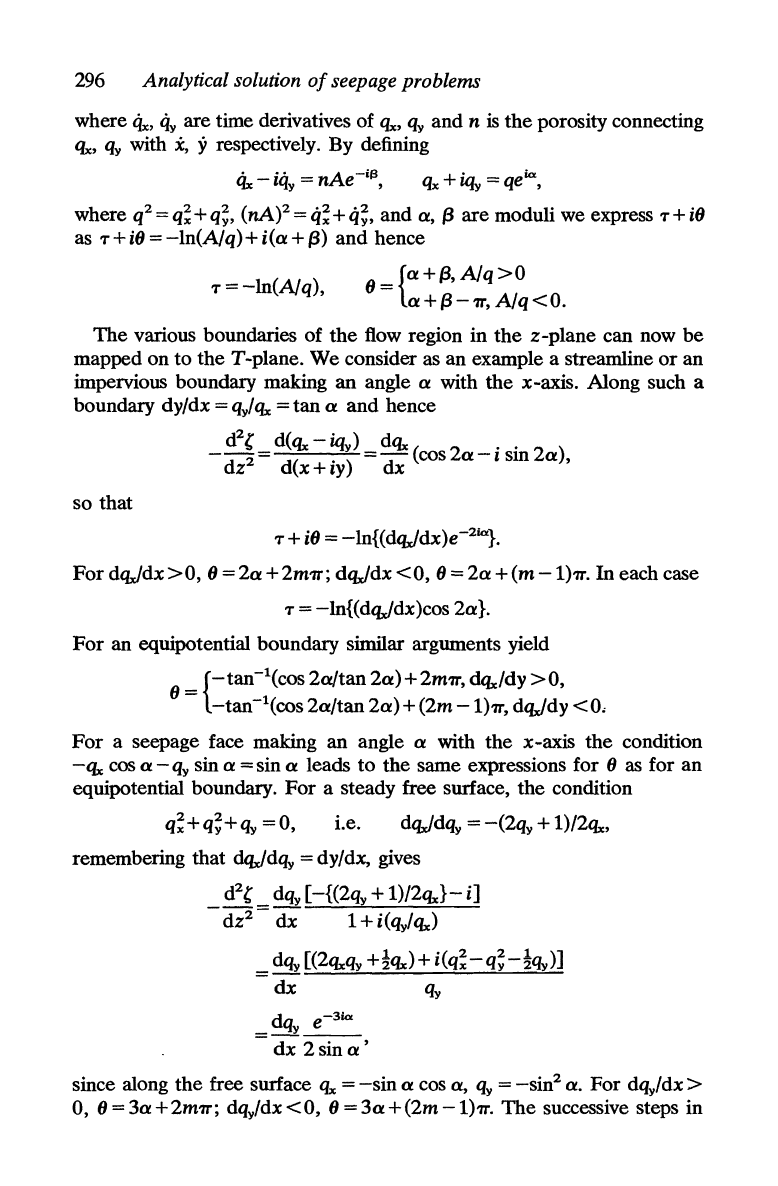
296 Analytical solution
of
seepage problems
where
qx,
qy
are time derivatives of
q",
qy
and n
is
the
porosity connecting
qx,
qy
with
X,
Y respectively. By defining
4c
-
iqy
=
nAe-
i13
,
qx
+
iqy
=
qe"'-,
where
q2=q~+q;,
(nA)2=q~+q;,
and
a,
~
are moduli we express
T+i6
as
T+i6=-ln(A/q)+i(a+m
and hence
T =
-In(A/q),
6 _
{a
+~,
A/q
>0
a+~-7f',A/q<O.
The
various boundaries of
the
flow region in
the
z -plane can now
be
mapped on to
the
T-plane. We consider as an example a streamline
or
an
impervious boundary making
an
angle a with
the
x-axis. Along such a
boundary dy/dx
=
qiq"
= tan a and hence
d
2
, d(q" -
iqy)
dq"
. .
--d
2=
d(
.)
-d
(cos2a-zsm2a),
z
x+zy
x
so that
T + i6 =
-In{(dqJdx)e-
2iot
}.
For
dqJdx
>0,
6 =
2a
+
2m7f';
dqJdx
<0,
6 =
2a
+ (m -1)7f'. In each case
T = -In{(dqJdx)cos
2a}.
For
an equipotential boundary similar argwnents yield
6
=
{-tan-
1
(cos
2a/tan
2a)+2m7f', dq,,/dy
>0,
-tan-
1
(cos
2a/tan
2a)+(2m-l)7f',
dqJdy
<0,
For
a seepage face making an angle a with the x-axis the condition
-q"
cos a -
qy
sin a = sin a leads
to
the same expressions for 6 as for an
equipotential boundary.
For
a steady free surface, the condition
q~+q;+qy=O,
i.e.
dqJdqy=-(2qy+l)/2q",
remembering that dqJdqy = dy/dx, gives
d
2
,
dqy
[-{(2qy +
1)/2q,,}-
i]
-
dz
2
= dx
l+i(qiq,,)
dqy
[(2q"qy
+~q,,)+
i(q~-q;-~qy)]
=-
dx
qy
dqy
e-
3iot
=
dx
2sina'
since along
the
free surface
q"
=
-sin
a cos
a,
qy
=
-sin
2
a.
For
dqidx>
0,
6=3a+2m7f';
dqidx<O,
6=3a+(2m-l)7f'.
The
successive steps in
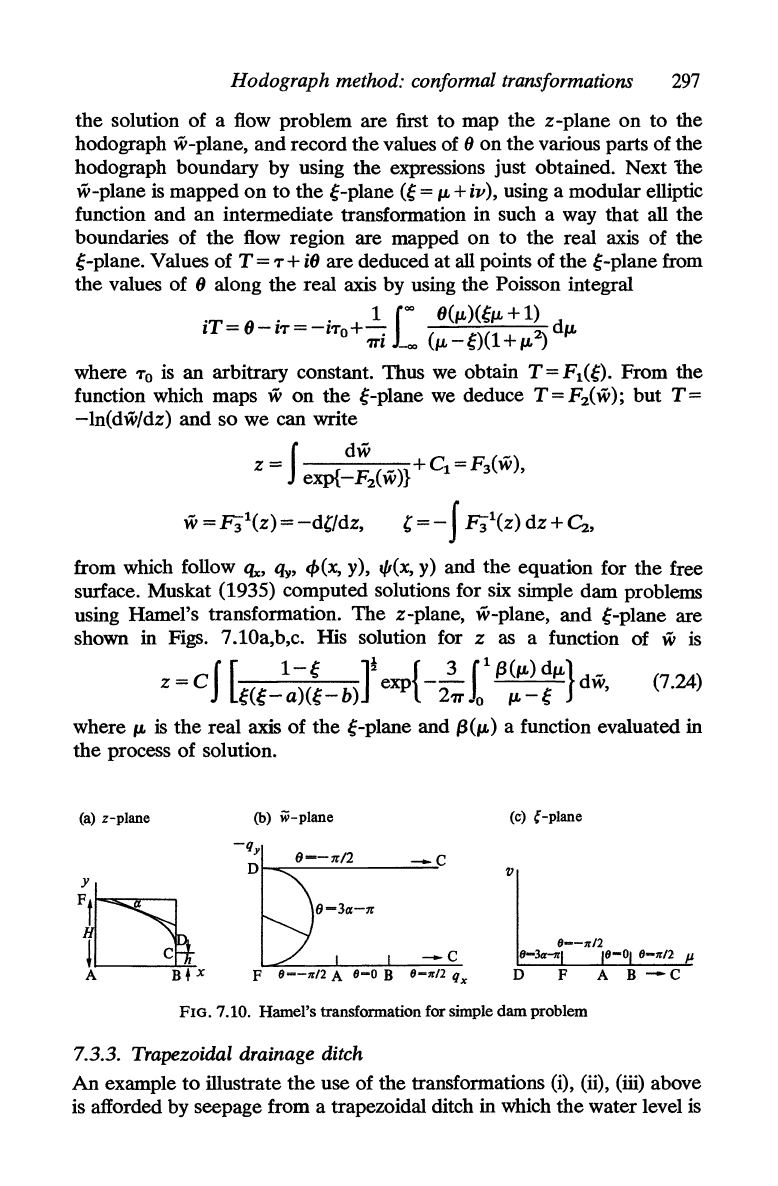
Hodograph method: conformal transformations
297
the
solution of a flow problem are first to map the z-plane
on
to the
hodograph w-plane, and record the values of
()
on
the
various parts of the
hodograph boundary by using
the
expressions just obtained. Next
The
w-plane
is
mapped
on
to
the
~-plane
(~=
p.,
+ iv), using a modular elliptic
function and an intermediate transformation in such a way that
all the
boundaries of
the
flow region are mapped
on
to the real axis of the
~-plane.
Values of T = 'T + i6 are deduced
at
all points of
the
~-plane
from
the
values of 6 along
the
real
axis
by using the Poisson integral
. . . 1 1
00
6(p.,)(~p.,
+ 1)
IT=
6-l'T=-l'To+
wi
-00
(p.,-~)(1+p.,2)
dp.,
where 'To
is
an arbitrary constant. Thus we obtain
T=Fl(~)'
From the
function which maps w on the
~-plane
we deduce
T=Fiw);
but
T=
-In(dw/dz) and so we can write
z =
f
eXP{~;iw)}
+C
1
=F
3
(w),
c=-
f
F3
1
(z)
dz+~,
from which follow q."
qy,
cf>(x,
y),
I/I(x,
y) and
the
equation for the free
surface. Muskat (1935) computed solutions for six simple dam problems
using Hamel's transformation.
The
z-plane, w-plane, and
~-plane
are
shown in Figs. 7.10a,b,c. His solution for z as a function of w
is
f[
1-~
]!
{ 3
[l~(p.,)dp.,}
-
z=C
~(~-a)(~-b)
exp
-2w.o
p.,_~
dw,
(7.24)
where
p.,
is
the real axis of
the
~-plane
and
~(p.,)
a function evaluated in
the
process of solution.
(a)
z-plane
;tkJ
Ll1
A
B4
x
(b) w-plane
-qy
D~~--~----~--~C
--c
(c)
,-plane
v
FIG. 7.10. Hamel's transformation forsimpie dam problem
7.3.3. Trapezoidal drainage ditch
An
example
to
illustrate
the
use of the transformations (i), (ii), (iii) above
is afforded by seepage from a trapezoidal ditch in which the water level
is
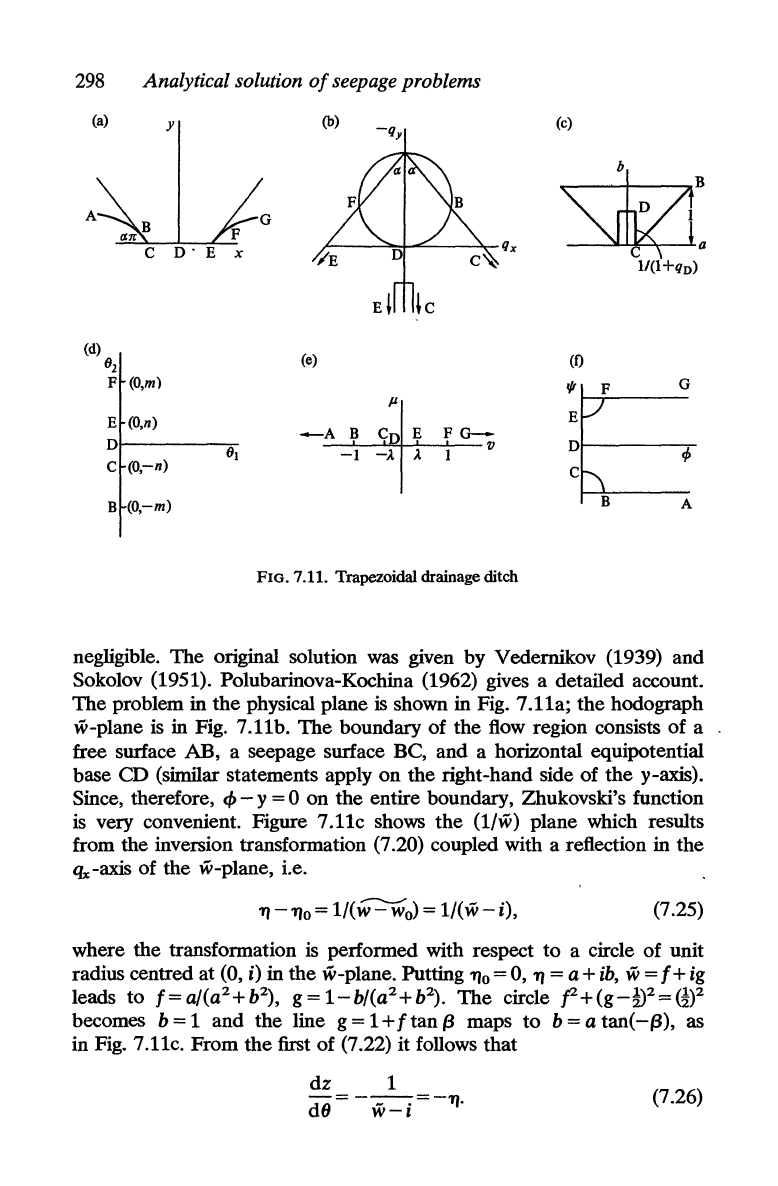
298
Analytical solution
of
seepage problems
(a)
y
A
(d)
e
l
F
(O,m)
E
(O,n)
DI------eT!
C (O,-n)
B (O,-m)
(e)
P
-A
B CD E F
G-
-1
-A
A v
FIG.
7.11. Trapezoidal drainage ditch
(c)
(0
:E
G
D
'"
C
B A
negligible. The original solution was given by Vedernikov (1939) and
Sokolov (1951). Polubarinova-Kochina (1962) gives a detailed account.
The problem in
the
physical plane
is
shown in Fig.
7.lla;
the
hodograph
w-plane
is
in Fig. 7.11b. The boundary of the flow region consists of a
free surface AB, a seepage surface BC, and a horizontal equipotential
base
CD
(similar statements apply
on
the
right-hand side of the y-axis).
Since, therefore,
cf>
- y = 0 on the entire boundary, Zhukovski's function
is
very convenient. Figure
7.llc
shows
the
(1/w)
plane which results
from the inversion transformation (7.20) coupled with a reflection in the
lJx
-axis of the w-plane, i.e.
(7.25)
where the transformation
is
performed with respect
to
a circle of unit
radius centred at (0,
i)
in
the
w-plane. Putting
110
= 0,
11
= a +
ib,
w = f + ig
leads to
f=
a/(a
2
+b
2
),
g =
1-b/(a
2
+b
2
).
The
circle
.f+(g_~?=G)2
becomes
b=l
and the line
g=l+ftan/3
maps
to
b=atan(-/3),
as
in Fig. 7.11c. From
the
first of (7.22) it follows that
dz
1
dB = -
w-i
=-11·
(7.26)
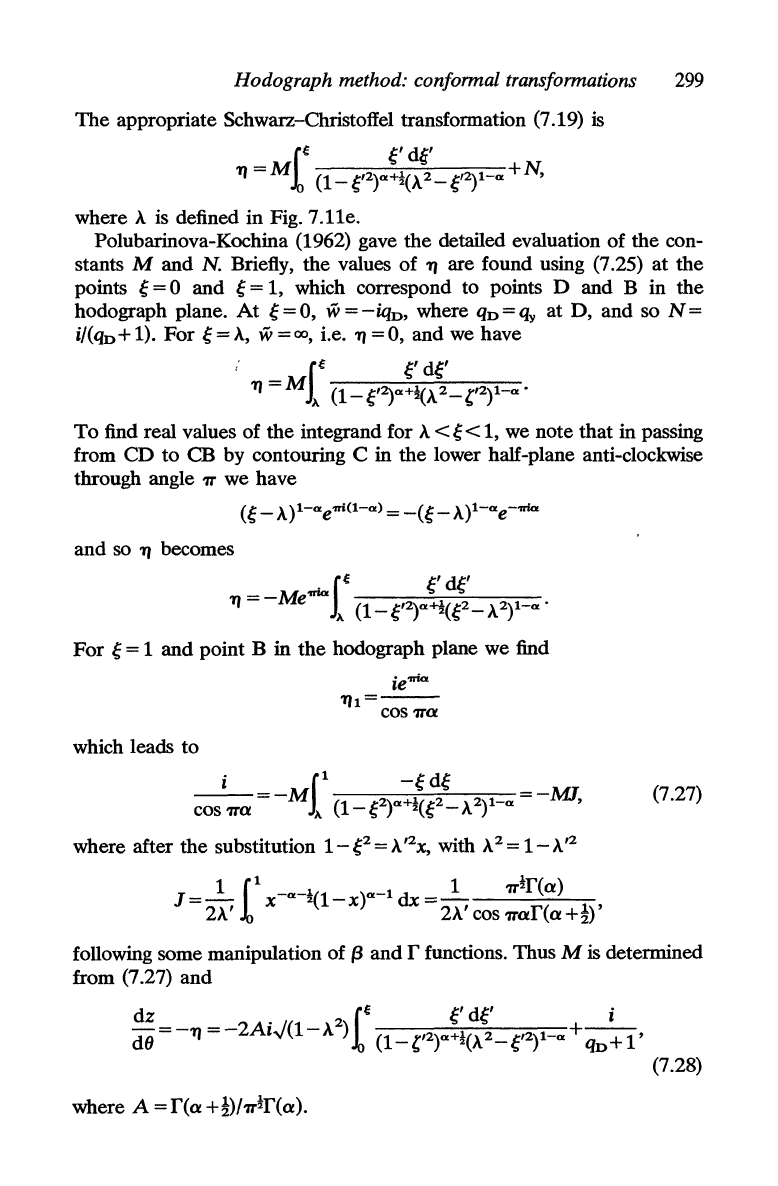
Hodograph method: conformal transformations
299
The
appropriate Schwarz-Christoffel transformation (7.19)
is
1
~
f dg'
'f/=M
(1_~'2)a+~(,,?_~'~1
a+
N
,
where A
is
defined
in
Fig.
7.l1e.
Polubarinova-Kochina (1962) gave the detailed evaluation of the con-
stants M and
N.
Briefly, the values of
'f/
are found using (7.25) at
the
points
~
= ° and
~
= 1, which correspond to points D and B in the
hodograph plane.
At
~
= 0, W =
-iqo,
where
qo
=
qy
at
D,
and so N =
i/(qo + 1). For
~
=
A,
W =
00,
i.e.
'f/
= 0, and
we
have
1
~
fdf
'f/
=M
~
(l-f~a+~A2_,'2)1-a·
To
find real values of the integrand for A <
~
< 1, we note that in passing
from
CD
to
CB by contouring C in the lower half-plane anti-clockwise
through angle
1T
we have
(~_
A)l-a
e
'lri(l-a)
=
_(~
_ A)l-a
e
-'Irio:
and so
'f/
becomes
olE
~'~'
'f/
=-M
e
'Jf1Cl.
~
(1-f~a~(e-A2)1-a·
For
~
= 1 and point B in
the
hodograph plane we find
which leads to
ie'lrio:
'f/1=--
cos 1Ta
i
11
-~d~
COS1Ta
=-M
~
(l-e)a+~(~2-A2)1
a
-MJ,
where after the substitution
1_~2=A'2X,
with A
2
=1-A,2
_~
11
-a-~
_ a-1
_~
1T~r(a)
1-
2A
, x
(1
x)
dx-
2
A'cos1Tar(a+t)'
(7.27)
following some manipulation of
(3
and
r functions. Thus M
is
determined
from (7.27) and
dz
. 2
IE
fdf
i
d6=-'f/=-2A
•
.J(1-A)
(l_C'2)a+!(A
2
-f
2
)1-a+
qo+1'
(7.28)
where A =
r(a
+t)/1T!r(a).
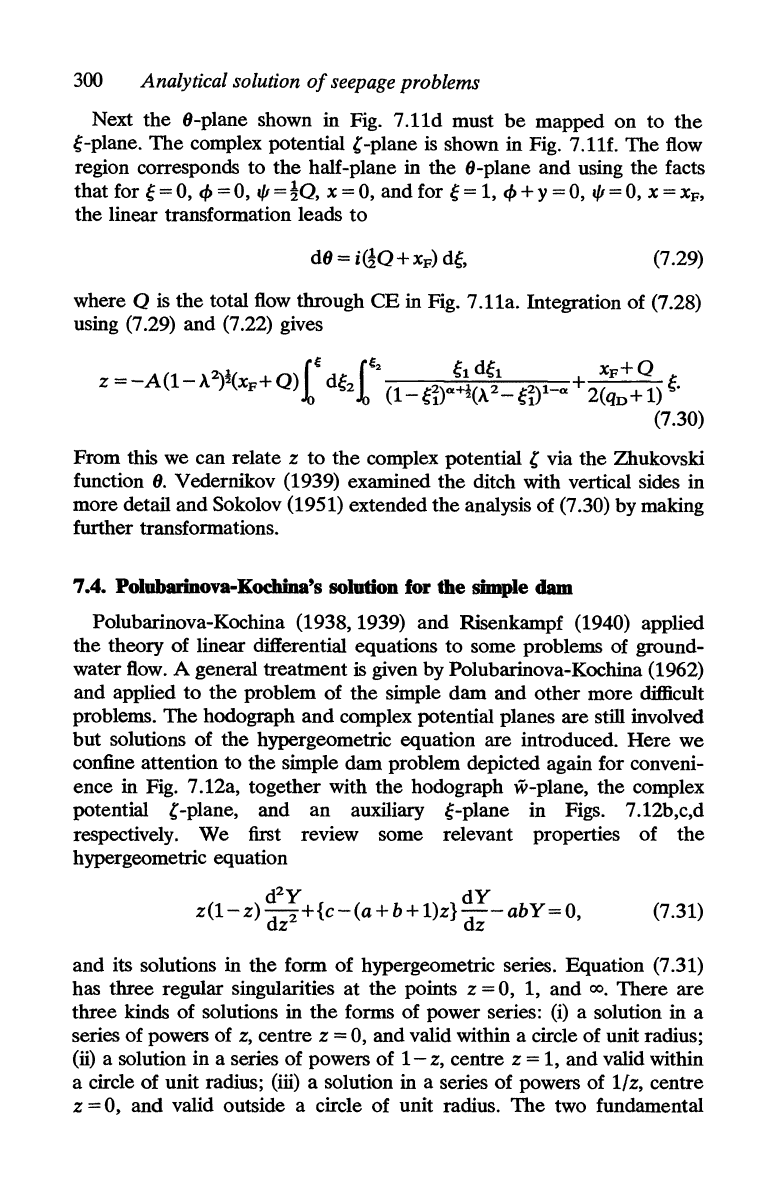
300
Analytical solution
of
seepage problems
Next the 8-plane shown in Fig. 7.11d must
be
mapped
on
to
the
g-plane.
The
complex potential
'-plane
is
shown in Fig. 7.11f. The flow
region corresponds to
the
half-plane in the 8-plane and using the facts
thatfor
g = 0,
cf>
= 0,
1/1
= !Q, x = 0, and for g = 1,
cf>
+ y = 0,
1/1
= 0, x =
XF,
the linear transformation leads
to
(7.29)
where
Q
is
the total flow through
CE
in Fig. 7.11a. Integration of (7.28)
using (7.29) and (7.22) gives
- - -
2\~
i~
i~2
gl dg
1
XF+
Q
z -
A(l
A.)
(XF+
Q)
dg
2
(1-
gi)a+~(A.
2_
gi)l-a
+ 2(qD+
1)
g.
(7.30)
From this we can relate
z
to
the
complex potential , via the Zhukovski
function
8.
Vedernikov (1939) examined the ditch with vertical sides in
more detail and Sokolov (1951) extended
the
analysis of (7.30) by making
further transformations.
7.4.
Polobarinova-KodUna's solution for the simple
dam
Polubarinova-Kochina (1938,1939) and Risenkampf (1940) applied
the theory of linear differential equations to some problems of ground-
water
flow.
A general treatment
is
given by Polubarinova-Kochina (1962)
and applied
to
the
problem of
the
simple dam and other more difficult
problems. The hodograph
and
complex potential planes are still involved
but solutions of the hypergeometric equation are introduced. Here we
confine attention to
the
simple dam problem depicted again for conveni-
ence in Fig. 7.12a, together with
the
hodograph w-plane, the complex
potential ,-plane, and an auxiliary g-plane in Figs. 7.12b,c,d
respectively.
We
first review some relevant properties of
the
hypergeometric equation
d
2
y
dY
z(l-z)
dz
2
+{c-(a+b+l)z}
dz
-abY=O,
(7.31)
and its solutions in the form of hypergeometric series. Equation (7.31)
has three regular singularities
at
the points z = 0, 1, and
00.
There are
three kinds of solutions in
the
forms of power series: (i) a solution in a
series of powers of
z,
centre z = 0, and valid within a circle of unit radius;
(ii) a solution in a series of powers of
1-
z,
centre z = 1, and valid within
a circle of unit radius;
(iii) a solution in a series of powers of 1{z, centre
z
=0,
and valid outside a circle of unit radius.
The
two fundamental
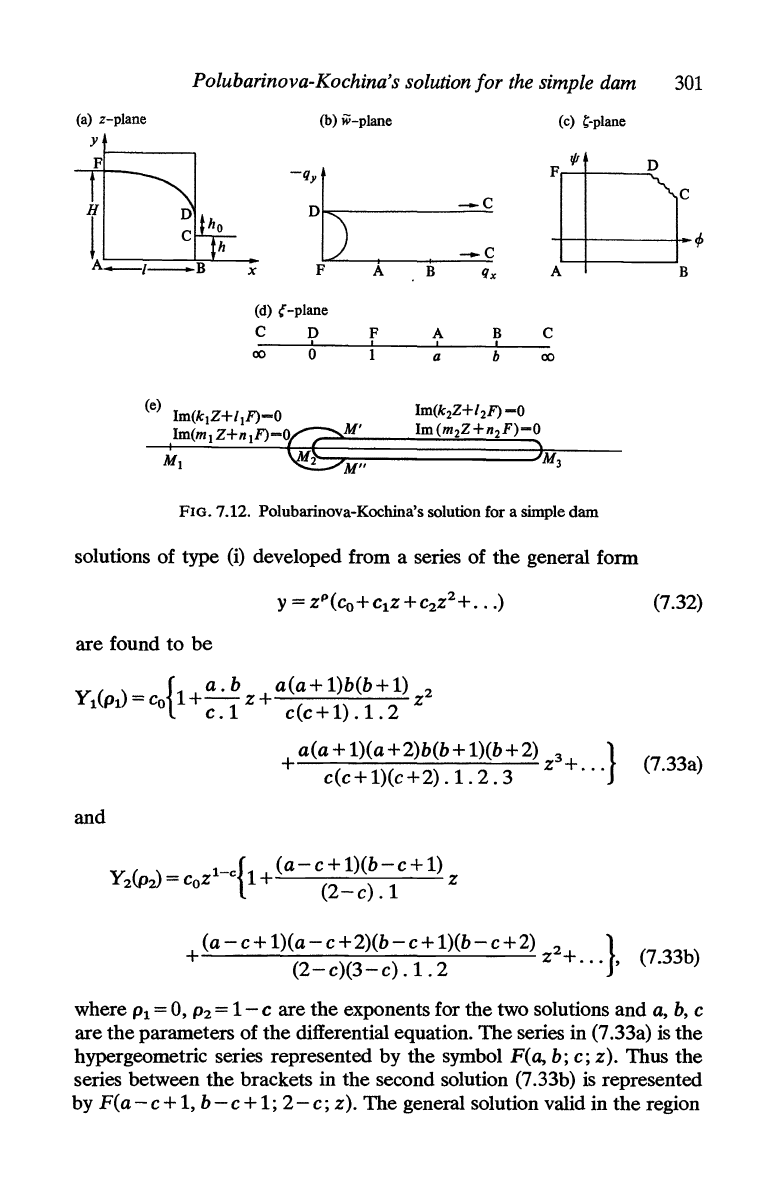
Polubarinova-Kochina's solution for
the
simple dam
301
(a)
z-plane
y
pt------,
(b) w-plane
D~
________
~--~C
x
(d)
(-plane
C D
00
b
A
p
1
_C
B
A
B
I I
a b
Im(k
2
Z+1
2
F)-O
Im(m2Z+n2F)-O
(c)
~-plane
'"
P
A
C
00
)M
3
FIG. 7.12. Polubarinova-Kochina's solution for a simple dam
solutions of type
(i)
developed from a series of
the
general form
are found to be
Y(
)
-
{1+a.b
a(a+1)b(b+1)
2
1P1-
C
O
1Z+
(
1)
12
Z
c.
c c+
..
a~+D~+~b~+D~+~
3 }
+
c(c+1)(c+2).1.2.3
Z +
...
and
Y
(p
\-
1-C{1
(a-c+1)(b-c+1)
221-
C
OZ +
(2-c).1
Z
D
C
B
(7.32)
(7.33a)
(a-c+1)(a-c+2)(b-c+1)(b-c+2)
2 } (7.33b)
+
(2-c)(3-c).1.
2 z +
...
,
where
P1
= 0,
P2
=
1-
c are
the
exponents for the two solutions and
a,
b,
c
are
the
parameters of
the
differential equation.
The
series in (7.33a)
is
the
hypergeometric series represented by
the
symbol F(a, b; c; Z). Thus
the
series between
the
brackets in the second solution (7.33b) is represented
by
F(a
- c + 1, b - c + 1; 2 -
c;
z).
The
general solution valid in
the
region
